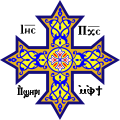Pambo of Nitria | |
|---|---|
 | |
| Desert Father Founder of Nitria | |
| Born | c. 305–315 Roman Egypt |
| Died | c. 375–390 (aged 70–75 years) Nitria, Roman Egypt |
| Venerated in | Oriental Orthodox Church Eastern Orthodox Church Roman Catholic Church |
| Feast | July 18 |
Pambo of Nitria [note 1] (died c. 390) was a Coptic Desert Father of the fourth century and disciple of Anthony the Great. His feast day is July 18 among the Oriental Orthodox, Eastern Orthodox, and Catholic churches.
Contents
- Biography
- Early monastic life
- Spiritual father and abbot
- Death
- Veneration
- Legacy
- Alleged Origenism
- Attributed liturgical views
- Later references
- Notes
- References
Pambo was a disciple of Anthony the Great. He lived in the Nitrian Desert where he founded many monasteries. He was renowned for his wisdom, and was consulted by many, including Athanasius, Melania the Elder, and Ammonas of Egypt. He was the spiritual father of several other canonized saints, including Pishoy and John the Dwarf.
